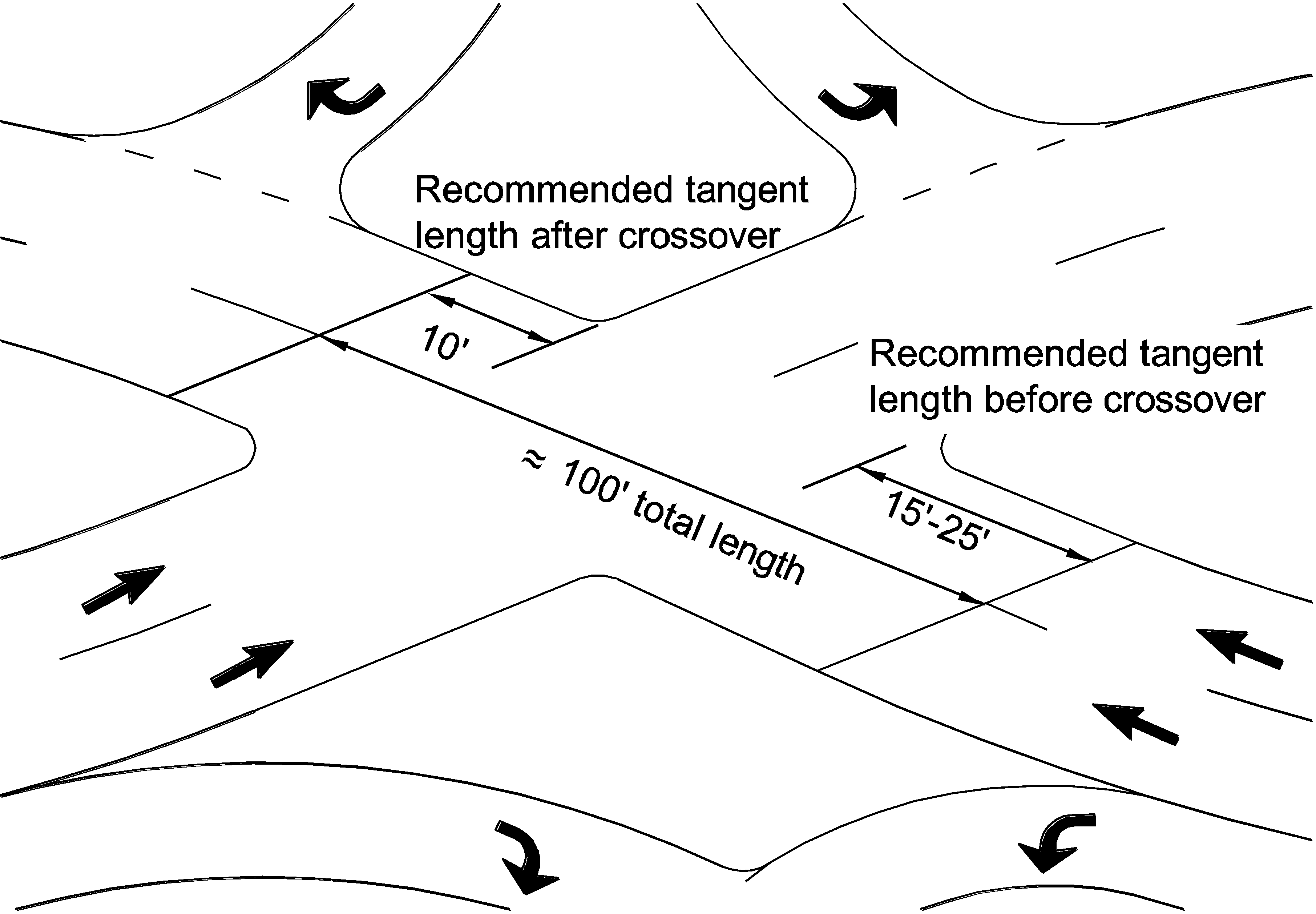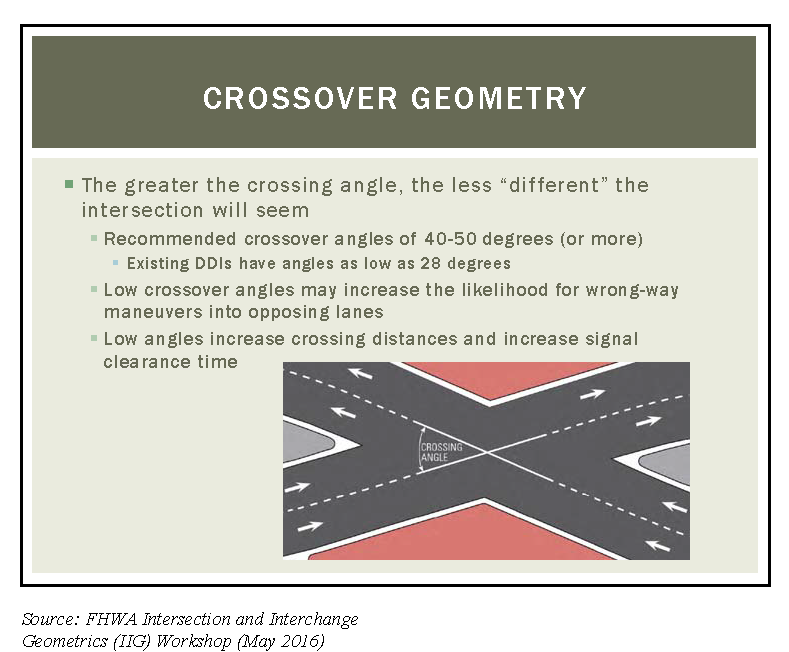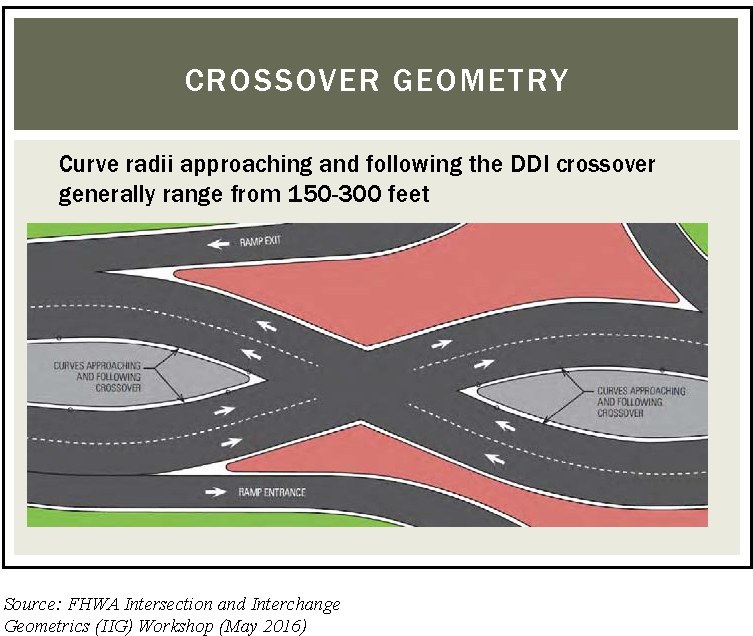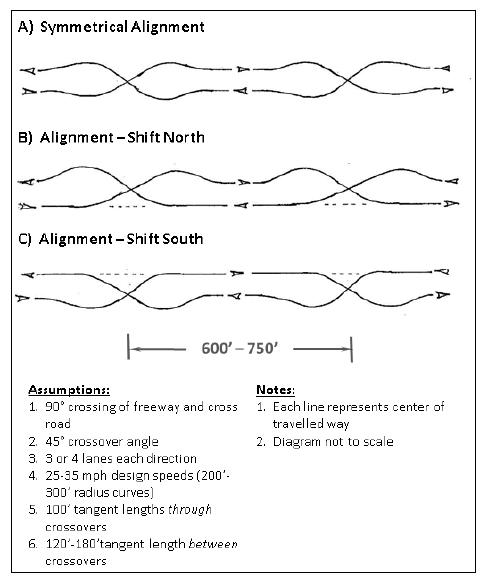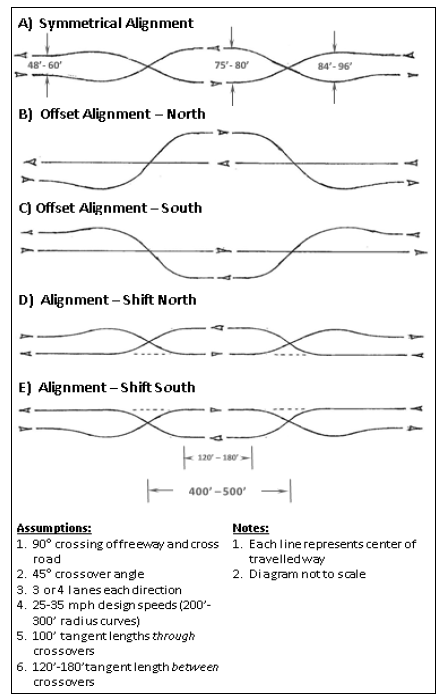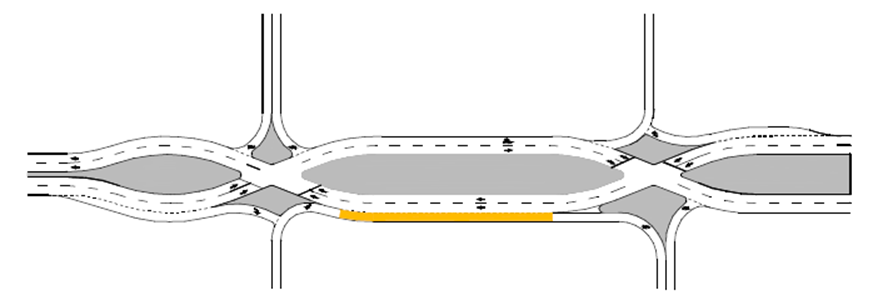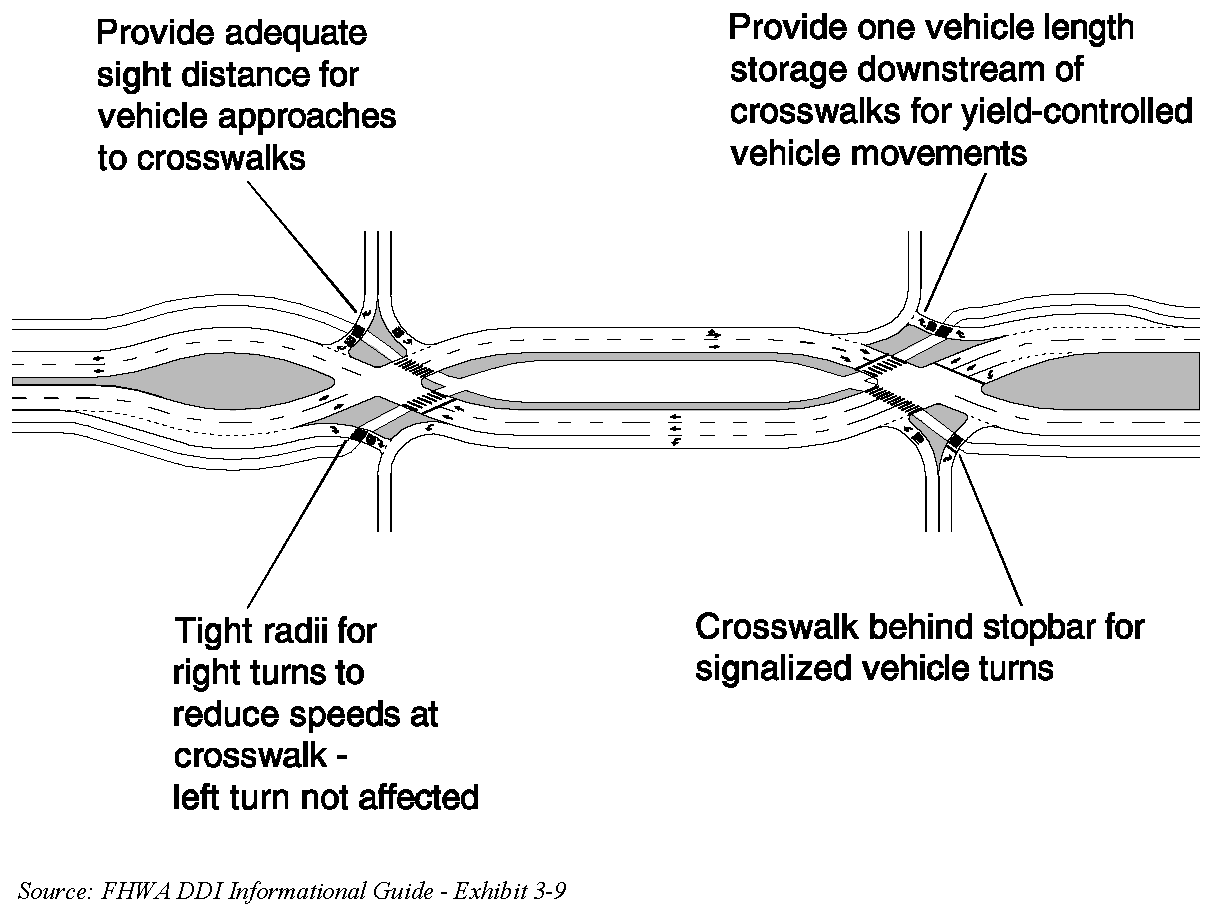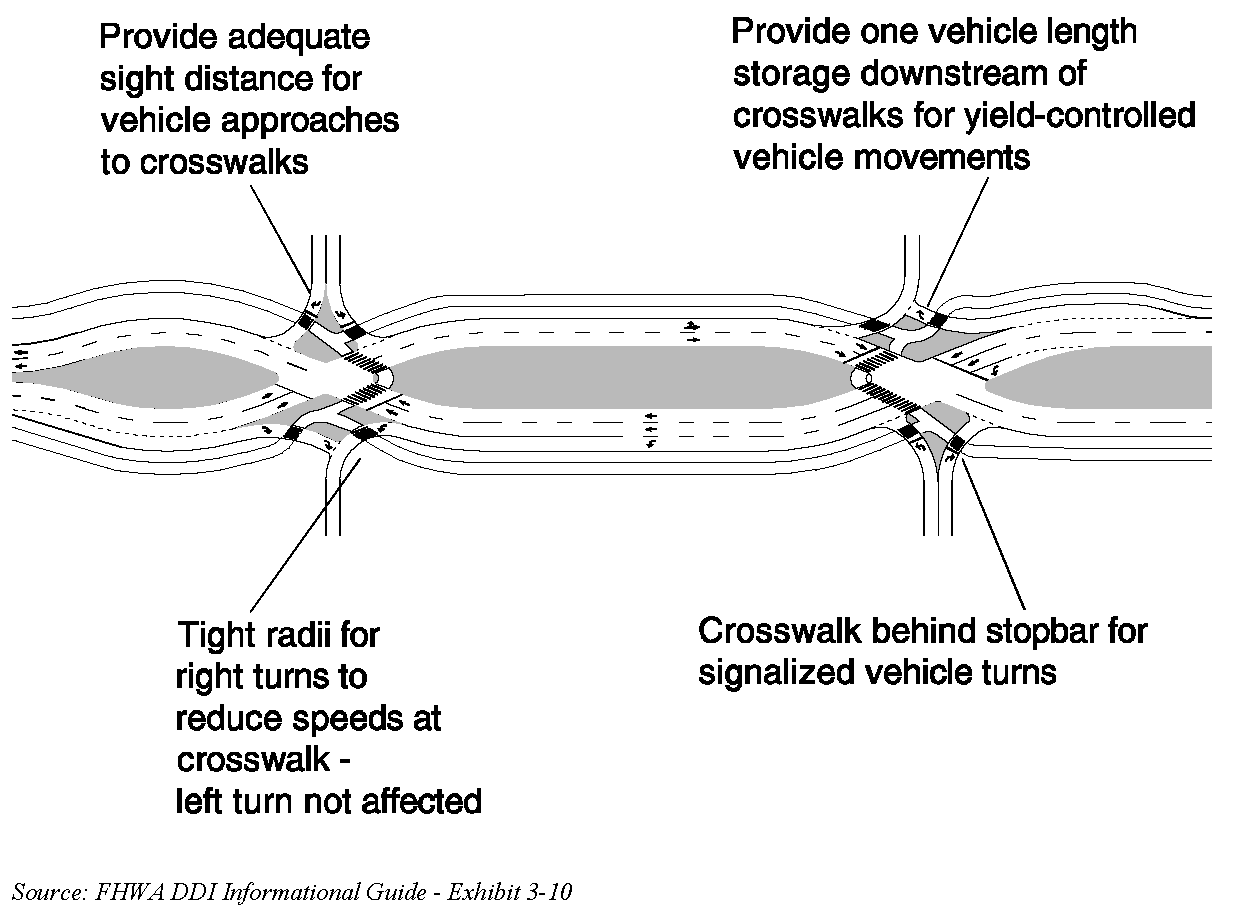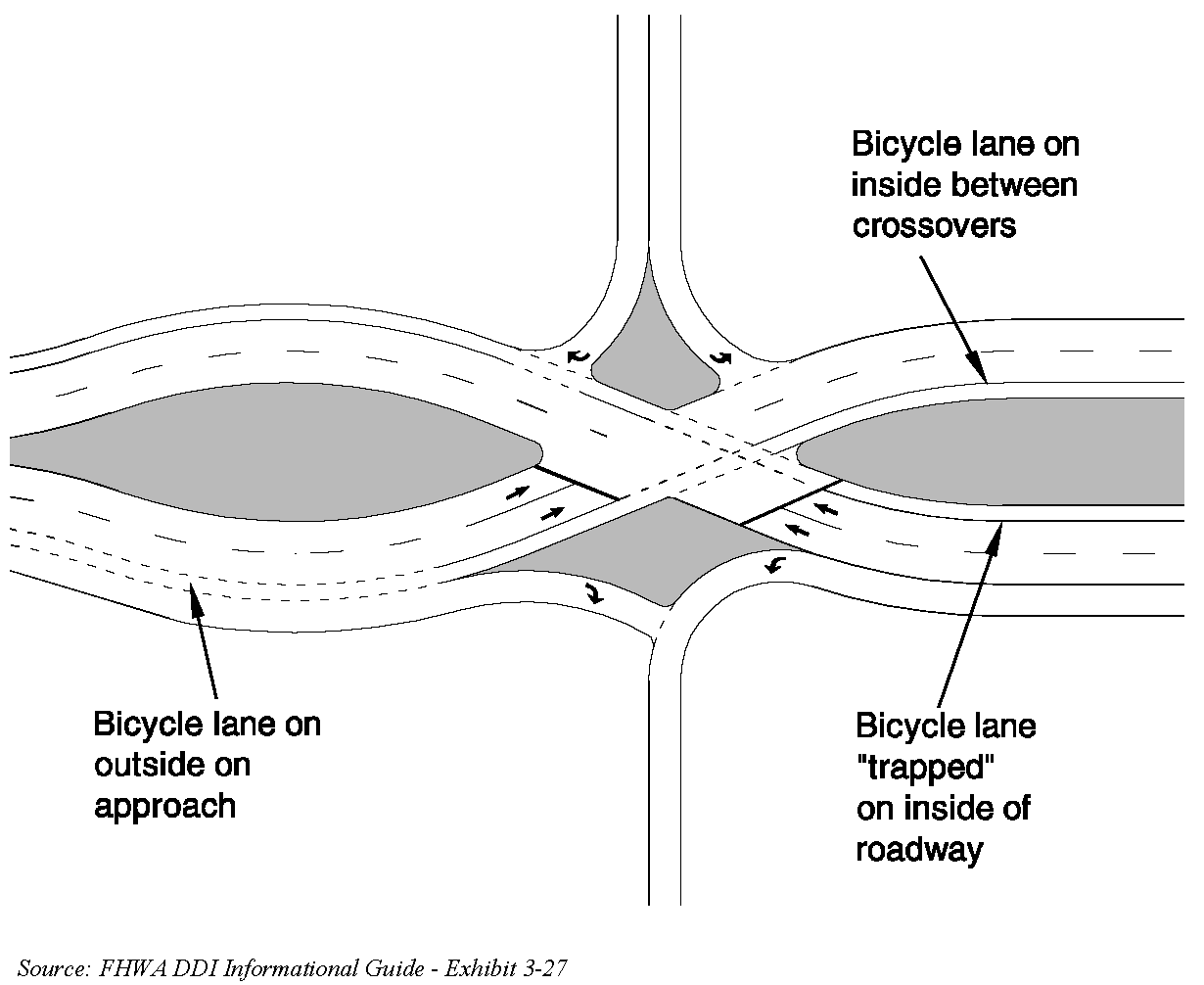Section 3: Diverging Diamond Interchange (DDI)
Anchor: #i1005502Overview
The Diverging Diamond Interchange (DDI) is an interchange form that allows the two directions of traffic on the crossroad to temporarily divide and cross to the opposite side to gain access to and from the freeway more easily. The primary difference between a DDI and a conventional interchange is the design of directional crossovers on either side of the interchange. This eliminates the need for left-turning vehicles to cross the path of approaching vehicles. By shifting cross street traffic to the left side of the street between the signalized intersections, vehicles on the crossroad making a left turn on to or off of ramps do not conflict with vehicles approaching from other directions. TxDOT has adopted the FHWA Diverging Diamond Interchange Informational Guide6 as the primary source for DDI guidelines. The information contained in this Appendix is considered a companion guide and is intended to document TxDOT’s suggested approach to DDI design.
Some of the documented benefits of a DDI include:
- Anchor: #UOFMYSFU
- Capacity improvements with two-phase signal configurations. Anchor: #MCFAHVRT
- Safety improvements due to a reduction in the number of conflict points. Anchor: #EKSWDUTG
- Possible lower costs due to a smaller footprint, shorter construction time, and the possibility of being able to salvage existing bridge structures.
Figure E-14 shows the design characteristics and key features of the DDI.
Figure E-14. Key Characteristics of a DDI
Anchor: #i1005547Design Considerations
Appropriate geometrics are central in the proper functioning of a DDI. The design vehicle is typically a WB-67 vehicle in Texas. The anticipated truck movements through the DDI should be determined and AutoTURN (or a similar tool) used to determine vehicle encroachments within the DDI. There is research underway to update the current turning movement templates since they are decades old and tend to be conservative. If a significant number of large trucks is anticipated through an intersection, it is advisable to find an area where the wheel paths of the respective design vehicle could be physically tested and documented. The largest truck movements may be accommodated by using a roll down curb in turning areas. The design speed of the DDI affects the reverse curve radii through the two intersection crossovers, and should typically range from 25 to 35 mph (see RDM Chapter 2, Section 4, Table 2-5 for corresponding curve radii values). The DDI profile should be relatively flat to increase driver sight distance. A tangent section is recommended before and after the crossovers to minimize the likelihood of wrong way maneuvers into opposing lanes, and the recommended crossover angle is 40-50 degrees or greater (see Figures E-15 and E-16 respectively). Figure E-17 depicts some typical curve radii ranges for lower-speed DDIs.
Figure E-15. Tangent Length Approaching and Departing the Crossover
Figure E-16. Crossover Geometry (Crossing Angle)
Figure E-17. Crossover Geometry (Curve Radii)
Anchor: #i1005584Sight Distance
Drivers approaching or departing an intersection must have an unobstructed view of traffic control devices and sufficient length along the cross road to safely navigate the intersection. Insufficient sight distance is a significant factor in street crashes and near collisions. As with any other intersection, DDI intersections must provide stopping sight distance (SSD) and intersection sight distance (ISD). Sight distances must be checked for these conflict areas: walls, railings, tall landscaping, or other obstructions that may limit sight distance. Intersection sight distance may also be limited by barriers or other obstacles between the crossovers.
Anchor: #i1005594Horizontal Alignment Alternatives
There are three alignment alternatives resulting in a minimum cross-section along the cross road regardless of whether the facility is an over-or under pass. There are two types of alignments: Symmetrical Alignment and the Shifted Alignment. Figure E-18 shows an example of symmetrical and shifted alignments. This results in distances of 600 to 750-ft between crossovers. If the distance between crossovers can be reduced it can boost traffic operations and limit the amount of right of way needed.
Figure E-18. Alignment Alternatives
Eliminating a few reverse curves can reduce the spacing between crossovers. Figure E-19 shows alignment alternatives where the number of reverse curves has been reduced with a resultant increase in median width. This results in distances of 400 to 500-ft between crossovers. Chapter 7 of the FHWA Diverging Diamond Interchange Informational Guide6 provides additional information on horizontal alignment options.
Figure E-19. Reduced Reverse Curves in Alignment Alternatives
Anchor: #i1005629Auxiliary Lanes
Auxiliary lanes would aid weaving traffic at a DDI interchange, smooth traffic flow, provide added capacity, and improve overall safety. Figures E-20, E-21, E-22, and E-23 show some examples of auxiliary lanes at a DDI interchange. Chapter 7 of FHWA Diverging Diamond Interchange Informational Guide6 provides additional information on auxiliary lanes.
Figure E-20. Auxiliary Left Turn Lane Between Crossovers (Not Preferred)
Figure E-21. Auxiliary Left Turn Lane Developed Prior to the First Crossover
Figure E-22. Auxiliary Lane, Shared Left and Through, Developed Prior to the First Crossover
Figure E-23. Auxiliary Through Lane Developed Prior to the First Crossover
Anchor: #i1005677Pedestrian and Bicyclist Considerations
DDIs have many benefits for pedestrians which include: Allowing more crossing time per phase due to the two-phase signal operations, crossing only one direction of traffic resulting in reduced conflicts, and fewer travel lanes for a pedestrian to cross.
DDIs provide the option to direct pedestrians to either the outside of the intersection or to a center walkway. The wide area between opposing traffic allows the opportunity for a large sidewalk down the center that can be bordered by concrete barrier to allow additional protection and channelization for the pedestrians. Pedestrian facilities on the inside minimize conflicts with traffic turning left to and from the freeway, and allow the crossing of the interchange in all directions. When placing the pedestrian sidewalk along the outside some important considerations are: the location of the crosswalk with respect to the bridge structure or other sight obstructions to maintain good visibility for both the pedestrians and vehicles, and considering the turning radii to reduce speeds in the vicinity of pedestrians. Figures E-24 and E-25 depict the inside and outside pedestrian sidewalk options, respectively.
Figure E-24. Pedestrian-focused DDI – Center Walkway
Figure E-25. Pedestrian-focused DDI – Outside Walkway
For bicyclists, the design should focus on minimizing bicycle conflicts with motor vehicles, providing adequate lateral space between vehicles and bicycles, minimizing speed differential between bicycle and vehicles, and managing bicycle-pedestrian conflicts. The 2 primary options for bicyclists on a cross street through a DDI are:
- Anchor: #XFRKAFTY
- A marked bicycle lane through the DDI. If a separate bicycle lane is provided, the preference is to locate it to the right of the vehicular traffic. Bicycle lane widths of 5 to 7-ft. are recommended through the DDI. (See Figure E-26) Anchor: #MEUFCXHL
- A separated sidewalk or wider shared-use path. This would typically entail the bicyclist disembarking on the upstream end of the DDI and then proceeding through the DDI in the same area designated for pedestrians.
Ultimately, a thorough site assessment, an assessment of anticipated bicycle and pedestrian volumes, and an assessment of projected origins and destinations for pedestrians and bicyclists should be conducted to determine the preferred method of movement through the DDI.
Figure E-26. Schematic for bicycle lane placement on right side of vehicular traffic
Anchor: #i1005744Access Management
From an access management standpoint, a DDI intersection provides full access control through the interchange. A traffic simulation should be conducted to determine the impacts and any needed mitigation for adjacent and nearby intersections in the corridor. Some of the possible disadvantages of a DDI include the following:
- Anchor: #KOHTWRPS
- Will not allow exit ramp to entrance ramp movements. Anchor: #PPNAMNTR
- Through movements along the frontage road can only be accommodated via bypass lanes or collector-distributor systems. Anchor: #RQMXHIWD
- May require modifications to nearby signalized intersections. Anchor: #BOCKJNIK
- Additional access management control beyond the interchange may be needed to prevent weaving maneuvers. Anchor: #MARWCMEI
- May require the relocating or removal of adjacent streets/driveways to accommodate crossover and reverse curves. Anchor: #WAPBHTXI
- Removes driveway access for corner development.
Reference the FHWA Alternative Intersections/Interchanges Informational Report (AIIR) for additional guidance with respect to access management.

